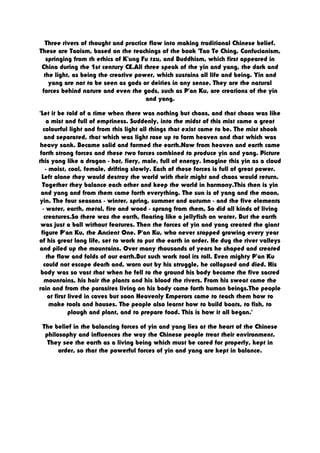
Chineese
- 1. Three rivers of thought and practice flow into making traditional Chinese belief. These are Taoism, based on the teachings of the book 'Tao Te Ching, Confucianism, springing from th ethics of K'ung Fu tzu, and Buddhism, which first appeared in China during the 1st century CE.All three speak of the yin and yang, the dark and the light, as being the creative power, which sustains all life and being. Yin and yang are not to be seen as gods or deities in any sense. They are the natural forces behind nature and even the gods, such as P'an Ku, are creations of the yin and yang. 'Let it be told of a time when there was nothing but chaos, and that chaos was like a mist and full of emptiness. Suddenly, into the midst of this mist came a great colourful light and from this light all things that exist came to be. The mist shook and separated, that which was light rose up to form heaven and that which was heavy sank. Became solid and formed the earth.Now from heaven and earth came forth strong forces and these two forces combined to produce yin and yang. Picture this yang like a dragon - hot, fiery, male, full of energy. Imagine this yin as a cloud - moist, cool, female, drifting slowly. Each of these forces is full of great power. Left alone they would destroy the world with their might and chaos would return. Together they balance each other and keep the world in harmony.This then is yin and yang and from them came forth everything. The sun is of yang and the moon, yin. The four seasons - winter, spring, summer and autumn - and the five elements - water, earth, metal, fire and wood - sprang from them, So did all kinds of living creatures.So there was the earth, floating like a jellyfish on water. But the earth was just a ball without features. Then the forces of yin and yang created the giant figure P'an Ku, the Ancient One. P'an Ku, who never stopped growing every year of his great long life, set to work to put the earth in order. He dug the river valleys and piled up the mountains. Over many thousands of years he shaped and created the flow and folds of our earth.But such work tool its toll. Even mighty P'an Ku could not escape death and, worn out by his struggle, he collapsed and died. His body was so vast that when he fell to the ground his body became the five sacred mountains, his hair the plants and his blood the rivers. From his sweat came the rain and from the parasites living on his body came forth human beings.The people at first lived in caves but soon Heavenly Emperors came to teach them how to make tools and houses. The people also learnt how to build boats, to fish, to plough and plant, and to prepare food. This is how it all began.' The belief in the balancing forces of yin and yang lies at the heart of the Chinese philosophy and influences the way the Chinese people treat their environment. They see the earth as a living being which must be cared for properly, kept in order, so that the powerful forces of yin and yang are kept in balance.